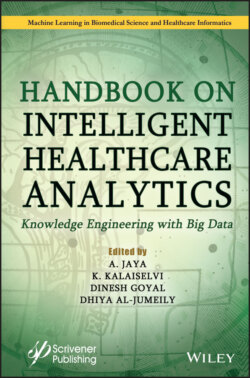Читать книгу Handbook on Intelligent Healthcare Analytics - Группа авторов - Страница 73
3.4.4 Big Data Analytics in Healthcare
ОглавлениеBig data analytics is the process of discovering knowledge. The stages of healthcare big data analysis are descriptive, diagnostic, predictive, and prescriptive [7, 27]. These analytical stages give the answer for the following questions:
• What happened to the patient?—Descriptive Analytics
• Why did it happen and when?—Diagnostic Analytics
• What will happen in the future?—Predictive Analytics
• How can we make it happen or not?—Prescriptive Analytics
The following are the categories of the healthcare big data analytics [18–20].
Descriptive analytics: This analytics summarizes past data in an easily readable format. This is like reporting. This gives the information, like what happened and when. The descriptive analytics in healthcare data gives the answer for the following questions:
• How many patients were in the emergency ward in the last month?
• How many numbers of patients have been infected because of epidemic disease in the last three months?
The descriptive analytics give the details for the above question using data. The descriptive analytics gives answers in simple statistical measures such as count and percentages.
For example, how many people have been infected with COVID-19 in the last month? From descriptive analytics, the hospital management can discover the number of people infected with COVID-19 in the last month. For example, we can discover from the descriptive analytics that 10,000 people are infected with COVID-19 in the last month. Descriptive analytics looks at the last month’s data and gives the answer in number. The government and the healthcare organization are able to identify the problem with current clinical aspects and get better healthcare practice, using the report of descriptive analysis. This is the first step of analyzing the big data that transforms the raw data into precious knowledge. Descriptive analytics is mainly for reporting, monitoring, and visualization.
Diagnostic analytics: This type of analytics gives information like what happened and why. The diagnostic analytics give explanation for the descriptive analytics data. The diagnostic analytics give answers for the following questions:
• Why were the patients infected with a particular disease last month?
• Why were the patients in the emergency ward last month?
The diagnostic analytics goes a little beyond reporting, that is, descriptive analytics. The above question can be answered using the data with the business intelligence for insight. For example, diagnostic analytics analyze the big healthcare data to discover the reason for why these patients are infected with COVID-19.
Predictive analytics: Predictive analytics uses machine learning and artificial Intelligence to analyze the present and the past data. This type of analytics is used to predict and forecast the future. The predictive analytics use descriptive data to forecast what will happen in the future possibly. This predictive analysis is the very significant analytics for predicting and diagnosing the disease. These types of analysis have capability for controlling and avoiding non communicable diseases like cancer, heart disease, stroke, and diabetes. Noncommunicable diseases are together accountable for most of the deaths worldwide. The predictive analytics use patient history and patient current health information to make medical decisions. The predictive analytics identify the following:
• Identify the patients who have the maximum possibility of getting diabetics, stroke, and heart attack?
• Identify the patients who have the maximum risk of hospitalization?
The above questions are answered using the data and machine learning for forecasting. In predictive analytics, the researchers and data analysts train a model using data mining algorithms, machine learning techniques, artificial intelligence, and the deep learning algorithms to predict the future events.
Prescriptive analytics: This analytics makes recommendations from the predicted output. The prescriptive analytics in healthcare is the last course of action in analyzing medical big data. This analysis has the capacity to suggest the action to overcome the problem in the healthcare organization. The imminent opportunity and challenges of medical big data is prescriptive analytics. Prescriptive analytics is the most advanced level of data analytics in medical big data. It is going to be realistic in the near future due to machine learning techniques, data science, cloud computing, deep learning, data engineering, and artificial intelligence.
These analytics give the recommendation or suggest action to change the prediction. Prescriptive analytics uses the data, the business intelligence for insight, and the machine learning for forecasting.
Big data analytics perform the above analysis using machine learning, artificial intelligence, and natural language processing to explore the unknown patterns and relationships among data.
